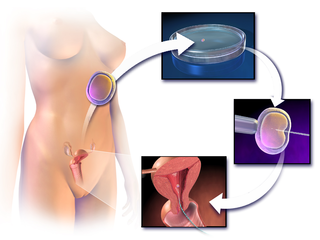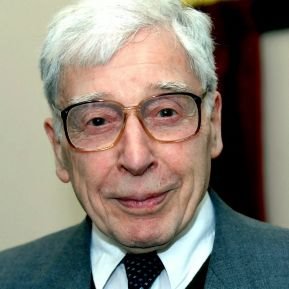Related Research Articles

In vitro fertilisation (IVF) is a process of fertilisation where an egg is combined with sperm in vitro. The process involves monitoring and stimulating a patient's ovulatory process, removing an ovum or ova from their ovaries and letting sperm fertilise them in a culture medium in a laboratory. After the fertilised egg (zygote) undergoes embryo culture for 2–6 days, it is transferred by catheter into the uterus, with the intention of establishing a successful pregnancy.
Gamete intrafallopian transfer (GIFT) is a tool of assisted reproductive technology against infertility. Eggs are removed from a woman's ovaries, and placed in one of the fallopian tubes, along with the man's sperm. The technique, first attempted by Steptoe and Edwards and later pioneered by endocrinologist Ricardo Asch, allows fertilization to take place inside the woman's uterus.

The Human Fertilisation and Embryology Authority (HFEA) is an executive non-departmental public body of the Department of Health and Social Care in the United Kingdom. It is a statutory body that regulates and inspects all clinics in the United Kingdom providing in vitro fertilisation (IVF), artificial insemination and the storage of human eggs, sperm or embryos. It also regulates human embryo research.

Patrick Christopher Steptoe CBE FRS was an English obstetrician and gynaecologist and a pioneer of fertility treatment. Steptoe was responsible with biologist and physiologist Robert Edwards and the nurse Jean Purdy for developing in vitro fertilisation. Louise Joy Brown, the first test-tube baby, was born on 25 July 1978. Edwards was awarded the 2010 Nobel Prize in Physiology or Medicine for his work on the development of in vitro fertilisation; Steptoe and Purdy were not eligible for consideration because the Nobel Prize is not awarded posthumously.

Assisted reproductive technology (ART) includes medical procedures used primarily to address infertility. This subject involves procedures such as in vitro fertilization (IVF), intracytoplasmic sperm injection (ICSI), cryopreservation of gametes or embryos, and/or the use of fertility medication. When used to address infertility, ART may also be referred to as fertility treatment. ART mainly belongs to the field of reproductive endocrinology and infertility. Some forms of ART may be used with regard to fertile couples for genetic purpose. ART may also be used in surrogacy arrangements, although not all surrogacy arrangements involve ART. The existence of sterility will not always require ART to be the first option to consider, as there are occasions when its cause is a mild disorder that can be solved with more conventional treatments or with behaviors based on promoting health and reproductive habits.
Elizabeth Jordan Carr is the United States' first baby born from the in-vitro fertilization procedure and the 15th in the world. The technique was conducted at Eastern Virginia Medical School in Norfolk under the direction of Doctors Howard Jones and Georgeanna Seegar Jones, who were the first to attempt the process in the United States. She was delivered at Norfolk General Hospital in Virginia by Dr. Mason Andrews weighing 5 pounds 12 ounces.

Georgeanna Seegar Jones was an American reproductive endocrinologist who with her husband, Howard W. Jones, pioneered in vitro fertilization in the United States.

Sir Robert Geoffrey Edwards was a British physiologist and pioneer in reproductive medicine, and in-vitro fertilisation (IVF) in particular. Along with obstetrician and gynaecologist Patrick Steptoe and nurse Jean Purdy, Edwards successfully pioneered conception through IVF, which led to the birth of Louise Brown on 25 July 1978. They founded the first IVF programme for infertile patients and trained other scientists in their techniques. Edwards was the founding editor-in-chief of Human Reproduction in 1986. In 2010, he was awarded the Nobel Prize in Physiology or Medicine "for the development of in vitro fertilization".

Subhash Mukherjee was an Indian scientist, physician from Hazaribagh, Bihar and Orissa Province, British India, who created the world's 2nd and India's first child using in-vitro fertilisation. Kanupriya Agarwal (Durga), who was born in 1978, just 67 days after the first IVF baby in United Kingdom. Afterwards, Dr. Subhash Mukherjee was harassed by the then West Bengal state government and Indian Government are not allowed to share his achievements with the international scientific community. Dejected, he committed suicide on 19 June 1981.

Peter Robert Brinsden MBBS, MRCS, LRCP, FRCOG is known for the treatment of infertility in couples. From 1989 to 2006 he was the medical director of Bourn Hall Clinic in the UK, a leading centre for the treatment of fertility problems, and where about 6,000 babies have been conceived using IVF and other assisted conception treatments.

Bourn Hall Clinic in Bourn, Cambridgeshire, England, is a centre for the treatment of infertility. The original building, Bourn Hall, is about 400 years old. Since becoming a medical centre, it has been greatly extended.
Religious response to assisted reproductive technology deals with the new challenges for traditional social and religious communities raised by modern assisted reproductive technology. Because many religious communities have strong opinions and religious legislation regarding marriage, sex and reproduction, modern fertility technology has forced religions to respond.

John Webster FRCOG is an English obstetrician and gynaecologist. Present at the world's first in vitro fertilisation (IVF) birth, Louise Brown, Webster has continued to develop and further research in the field of IVF.
Mitochondrial replacement therapy (MRT), sometimes called mitochondrial donation, is the replacement of mitochondria in one or more cells to prevent or ameliorate disease. MRT originated as a special form of in vitro fertilisation in which some or all of the future baby's mitochondrial DNA (mtDNA) comes from a third party. This technique is used in cases when mothers carry genes for mitochondrial diseases. The therapy is approved for use in the United Kingdom. A second application is to use autologous mitochondria to replace mitochondria in damaged tissue to restore the tissue to a functional state. This has been used in clinical research in the United States to treat cardiac-compromised newborns.
Spontaneous conception is the conception and birth of a subsequent child, after the birth of a child conceived through in vitro fertilisation or other forms of assisted reproductive technology. There is an overall 18% chance of spontaneous conception after an in vitro fertilization (IVF) treatment, but that chance rose to 37% among younger women. The likelihood also depends on the sperm performance of the man and the egg count of the woman.
Natural Cycle In Vitro Fertilization (IVF) is an assisted reproductive technique designed to closely mimic a woman's natural menstrual cycle. In traditional IVF, a woman's ovaries are stimulated with fertility medications to produce multiple eggs, which are then retrieved and fertilized outside the body. A natural cycle IVF, on the other hand, works with the woman's natural hormonal fluctuations and ovulation cycle.
The history of in vitro fertilisation (IVF) goes back more than half a century. In 1959 the first birth in a nonhuman mammal resulting from IVF occurred, and in 1978 the world's first baby conceived by IVF was born. As medicine advanced, IVF was transformed from natural research to a stimulated clinical treatment. There have been many refinements in the IVF process, and today millions of births have occurred with the help of IVF all over the world.
Simon Fishel is an English physiologist, biochemist and pioneering in vitro fertilisation (IVF) specialist.

Jean Marian Purdy was a British nurse and embryologist and a pioneer of fertility treatment. Purdy was responsible with Robert Edwards and Patrick Steptoe for developing in vitro fertilisation. Louise Joy Brown, the first test-tube baby, was born on 25 July 1978, and Purdy was the first to see the embryonic cells dividing. Edwards was awarded the 2010 Nobel Prize in Physiology or Medicine for his work on the development of in vitro fertilisation; however, because the Nobel Prize is not awarded posthumously, neither Purdy nor Steptoe were eligible for consideration. Purdy was a co-founder of the Bourn Hall Clinic but her role there and in the development of IVF was ignored for 30 years.
Joy is an upcoming film starring Bill Nighy, Thomasin McKenzie and James Norton. Directed by Ben Taylor, it is the true story of the world’s first in vitro fertilisation baby. The script is by Jack Thorne who developed the story with his wife Rachel Mason. It is produced by Wildgaze and Pathé for Netflix.
References
- ↑ Walsh, Fergus (14 July 2008). "30th birthday for first IVF baby". BBC News . Retrieved 9 August 2020.
- ↑ "Louise Brown and Her Parents | Encyclopedia.com". encyclopedia.com. Retrieved 14 July 2021.
- ↑ "Louise Brown: World's first IVF baby's family archive unveiled". BBC News. 24 July 2018. Retrieved 29 July 2021.
- ↑ "'I was the world's first IVF baby, and this is my story'". The Independent. 25 July 2018. Retrieved 29 July 2021.
- ↑ Hutchinson, Martin (24 July 2003). "I helped deliver Louise". BBC News. Retrieved 9 August 2020.
- 1 2 3 4 "World's first IVF baby marks 30th birthday", Archived 26 July 2008 at the Wayback Machine Agence France-Presse, 23 July 2008. Retrieved 24 July 2008.
- ↑ Weule, Genelle (25 July 2018). "The first IVF baby was born 40 years ago today". ABC News . Retrieved 25 July 2018.
- ↑ Wade, Nicholas (4 October 2010). "Pioneer of in Vitro Fertilisation Wins Nobel Prize". The New York Times . Retrieved 5 October 2010.
- ↑ "Unsung heroine who saved refugees from Nazis honoured in Leeds". The Guardian. 8 March 2022. Retrieved 8 March 2022.
- 1 2 Hall, Sarah (11 July 2006). "Louise Brown, first test tube baby, is pregnant". The Guardian . London. Retrieved 9 August 2020.
- ↑ "Baby son joy for test-tube mother". BBC News . 14 January 2007.
- ↑ "The first IVF baby, Louise Brown, was born in 1978 in the United Kingdom". KrishnaIVF News . 14 January 2007.
- 1 2 Grady, Denise (23 June 2012). "Lesley Brown, Mother of World's First 'Test-Tube Baby,' Dies at 64", The New York Times . Retrieved 8 August 2020.
- ↑ "First test tube baby mother Lesley Brown dies". BBC News . 20 June 2012. Retrieved 20 June 2012.
- ↑ Marantz Henig, Robin. Pandora's Baby, Houghton Mifflin, 2004, p 134
- ↑ Prospettive nel Mondo,1 August 1978; Luciani, Opera Omnia, vol. 8, pp. 571–72.
- ↑ Eley, Adam (23 July 2015). "How has IVF developed since the first 'test-tube baby'?". BBC News . Retrieved 9 August 2020.